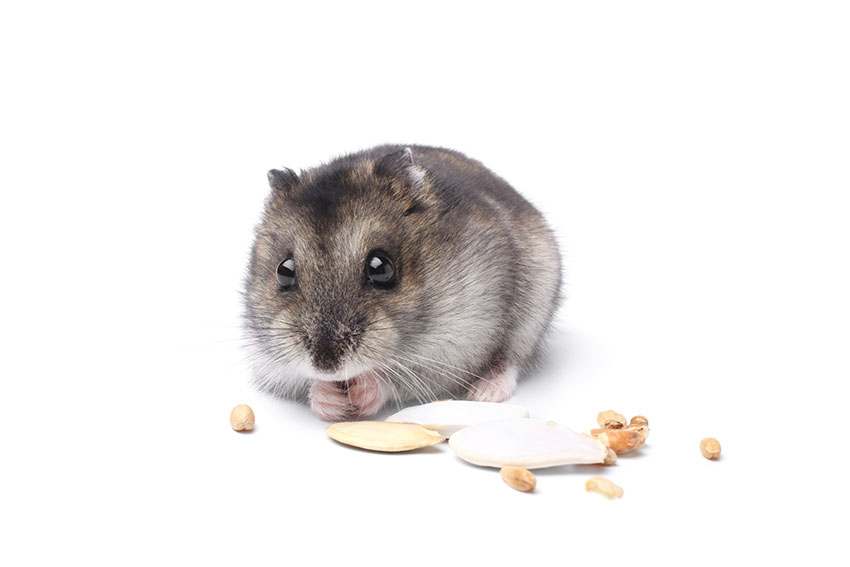Hamsters are widely available to new owners, if you know where to look. The two main options for obtaining your new pet are adopting or buying a hamster. We’ll help you learn about each process, how they may differ, and what to expect with hamsters from different backgrounds.
Adopting a hamster
Adopting a hamster in need can be very rewarding. Like other pets, some homes commit to keeping a hamster, but find themselves no longer able to care for them or take them along during a move. Here’s what to know if you decide to adopt a hamster.
Where to look
Surrendered hamsters can be found at animal shelters or rescue groups. You can find these organizations through an online search, social media pages, or through word-of-mouth. Not all animal shelters accept small pets, so be sure to call your local animal shelters or visit their website to inquire about available pets.
Pros and cons of adopting a hamster
Adopting a pet can save their life, which can be a wonderful experience for both you and your hamster. But, adopting a pet can come with its own set of challenges. Here are the pros and cons to adopting a hamster.
Pros:
- Rescuing a hamster from a shelter can save their lives
- Adoption fees can be lower than buying a hamster
- Most shelters will have veterinarians that have done a health check on adoptable hamsters
- Shelter employees or rescue group volunteers can give you insight to a hamster’s personality
Cons:
- Age and background is often unknown
Buying a hamster
Buying a hamster is a common way of bringing your new pet home. Obtaining a hamster this way can be faster and more convenient than finding one to adopt, but again, comes with its own unique considerations. Here are some helping tips on finding hamsters to buy.
Pet stores
Most pet stores carry small pets like fish, mice, and hamsters. Depending on the size of the retailer, they may have more than one breed available, and may carry males or females. It’s important to ask who supplies their hamsters though – some hamsters can come from unethical breeding operations (rodent mills), and the hamsters supplied to pet stores may not be healthy or hardy.

Hamsters are available in many different shelters
Breeders
Breeders are an excellent resource when it comes to finding a hamster to purchase. You can find breeders through online searches or social media, or through other hamster owners. Some breeders focus on a specific species of hamster, or breed for select colors, patterns, or coat texture. Ethical breeders will have sanitary living conditions, and will produce quality pets that are both healthy and thriving.
Pros and cons of buying a hamster
Like adopting, there are pros and cons to buying a hamster from a pet store or breeder. Here are some things to consider before deciding on buying a hamster rather than adopting one.
Pros:
- Breeders can be sure of the age of your hamster, and pet stores should have a good idea of how old your hamster is
- A wider selection of hamsters can be found through stores and breeders
- Hamsters are more readily available
Cons:
- Potentially more expensive to obtain, especially if you select a hamster that has been bred for a specific coat or color
- Depending on your location, it may be difficult to find a reputable breeder or ethical pet store nearby
Which hamster should I get?
Once you’ve found adoptable hamsters through shelters, rescue groups, breeders, or pet stores, you’ll be tasked with choosing a hamster among the many options available. With so many adorable faces, it can be difficult to narrow it down to just one. But we’ve created a list of considerations to help you make the best choice.
Decide which breed is best
With 5 breeds of domesticated hamsters available, you’ll need to decide which is best for you. For the majority of species, hamsters need to be kept alone, as they are very territorial. The exception to this rule is that some dwarf hamsters, namely the Roborovski hamster, can be kept in pairs or small groups if they have enough space.
Dwarf breeds are more energetic and lively in their enclosures than large hamsters like the Syrian, but they’re also more difficult to handle. Smaller hamsters make good pets to observe, so if you’re looking for a hamster breed that is easy to handle, or if the hamster will be for a child, a full-size variety like the Syrian or Chinese hamster is recommended.
Color or coat length might not be a consideration for everyone, but if it’s important to you, choosing a Syrian hamster will give you the most variety in coat and color. Syrian hamsters have been bred for multiple colors, patterns, and coat length and textures.
With these in mind, here are the following questions to ask yourself before choosing which breed is best for you:
- Do you want to keep more than one hamster?
- Do you want a pet to hold, or a spirited variety to observe in their habitat?
- Do you want a unique coat color, pattern, or texture in your hamster?
Based on how you answer these questions, you’ll be able to select the best breed for you or your family.

Syrian hamsters can be very friendly and characterful
Assess their personality
Like all animals, hamsters will all have their own individual personalities and quirks. If you’re adopting an adult hamster, you’ll be able to see their personality on full display. All hamsters can be tamed further, but younger hamsters are more easily molded into pets that you can handle and play with. It’s also important to remember that animal shelters or noisy pet stores may cause some hamsters to be more shy, but once you bring them home into their ideal environment, they may come out of their proverbial shell. So, when choosing one hamster among the many, look for the personality traits you’d like in a pet, with the caveat that a more timid hamster may gain confidence and become more outgoing once they’re settled into their forever home.
Look for healthy hamsters
Most reputable breeders, pet stores, rescue groups, or animal shelters with access to veterinary care will not offer hamsters that are not in their best health. Healthy hamsters will be alert during their waking hours, have clear, bright eyes, and full, shiny coats. These should all be apparent in hamsters that are in shelters, foster homes, pet stores, or breeders’ facilities. Don’t bring home a hamster with missing patches of hair, visible wounds or parasites, discharge from the nose, eyes, mouth, or ears, or those that act lethargic. If you decide to rescue a hamster from poor living conditions, be prepared to take them to a veterinarian right away for treatment.
Choosing a male or female hamster
Gender is another consideration when choosing your hamster. In general, males tend to be more easy-going, while females are more lively. Female hamsters will go through their heat cycle every few days, which will increase their odor. So, you’ll want to weigh which is more important to you: a female companion full of character, but may be smellier; or a laid-back male with potentially less personality and odor.
Omlet and your hamster
Choosing your hamster is exciting to be sure, but finding your perfect pet may take some time. While you search for the right hamster, you can create the perfect setup to bring them home to. With a spacious hamster habitat, customisable tunnel trails, and a secure hamster playpen, your new companion will experience the warmest welcome into their new home. And once they’ve settled in, you’ll both be able to enjoy playtimes with endless possibilities.
Comments
There are no comments just yet